Bondy’s Operation
In ears with an attic cholesteatoma, good hearing, and an intact pars tensa, the original Bondy’s operation can be performed using a retroauricular or an endaural approach.
With the retroauricular approach, the basic techniques of cortical mastoidectomy are described in Chapter 4. After the lateral mastoid cells have been exenterated (Figs. 147 to 151), the Körner’s septum is removed and the antrum opened (Figs. 189 to 191).
In attic cholesteatoma with diminished pneumatization, a large cholesteatoma occupying the entire antrum is exposed (Fig. 568). After drilling of the overhangs along the middle fossa dura and the posterior fossa dural plates and thinning of the bony ear canal wall, the lateral half of the cholesteatoma is exposed (Fig. 569). In order to obtain space to remove the ear canal wall, the cholesteatoma sac is opened and the cholesteatoma mass is removed, allowing the cholesteatoma membrane to be further elevated from the bony ear canal wall (Fig. 570). Removal of the cholesteatoma mass is achieved by using a thick suction tube and a rugine. The cholesteatoma mass is reduced, and the surrounding bone is carefully polished, with removal of all overhangs from the mastoid tegmen and tegmen antri as well as from the posterior fossa dural plate.
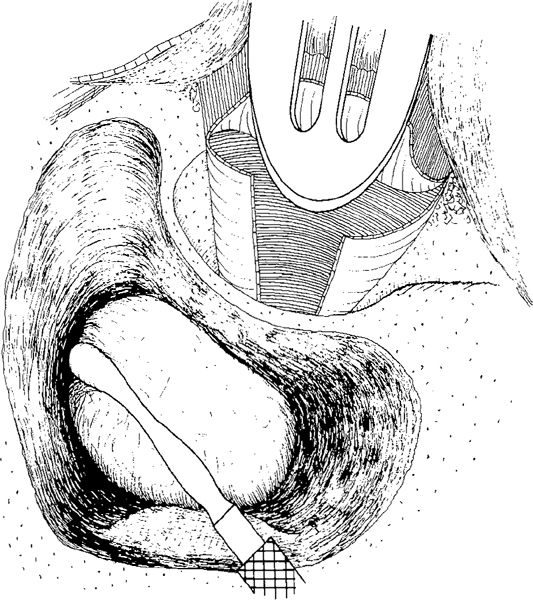
Fig. 568 The technique of the Bondy operation. A cortical mastoidectomy is performed using the retroauricular approach, and the ear canal skin is elevated from the posterior aspect of the meatus. The lateral mastoid air cells are exenterated, Körner’s septum is removed, and the lateral part of the attic cholesteatoma occupying all the antrum is located. Using Freer’s rugine, the matrix is elevated
In some cases, the cholesteatoma matrix is smooth and surrounded by a thin layer of connective tissue separating it from the surrounding sclerotic bone. Sometimes the cholesteatoma matrix is closely applied to the bone, with fingerlike extensions into small cells. Such extensions should be carefully removed as indicated in Chapter 4, Figures 219 to 239. When the cholesteatoma mass has been completely removed either by suction or by instruments, the medial anterior borders of the cholesteatoma membrane are delineated, especially from the bony ear canal wall. After elevation of the meatal skin, the bony ear canal is removed piecemeal using a strong rongeur as far as the bridge (Fig. 571) or until the attic perforation is reached. The rest of the bridge is removed using a curette, directed outward to avoid luxation of the incus lying under the cholesteatoma matrix (Fig. 572). There now follows the removal of the posterior and anterior buttresses and polishing of the anterior meatal wall, so that the anterior ear canal wall continues directly into the tegmen tympani and mastoid tegmen. Posteriorly, the bony ear canal wall is removed, and the facial ridge is lowered and polished using a diamond burr. Finally the cholesteatoma membrane, which is left in place as exteriorized epidermis, is checked, especially medially, and a search is made for fingerlike ingrowth into the perilabyrinthine air cells. If such cells are invaded by cholesteatoma, they should be removed along with the matrix; a smaller area of the matrix is then left in place (Fig. 573).
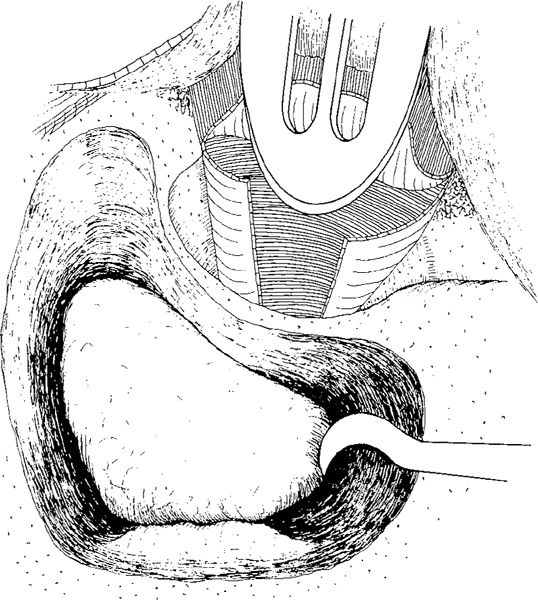
Fig. 569 The borders of the cholesteatoma are carefully inspected and elevated all the way around, with the mastoid tegmen being localized superiorly, and the sinodural angle and posterior dural plate region, as well as the bony ear canal wall, being localized posteriorly. The cholesteatoma sac has not been opened yet
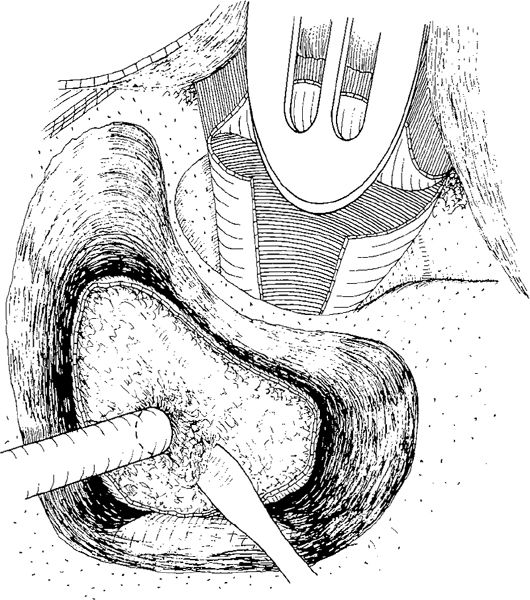
Fig. 570 The cholesteatoma sac has been opened, and the lateral half of the matrix removed. Using a large suction the cholesteatoma mass is removed inside the matrix elevating the various layers of the cholesteatoma mass using a Freer’s rougine. The matrix is further elevated all the way around exposing the bony walls of the antrum and attic
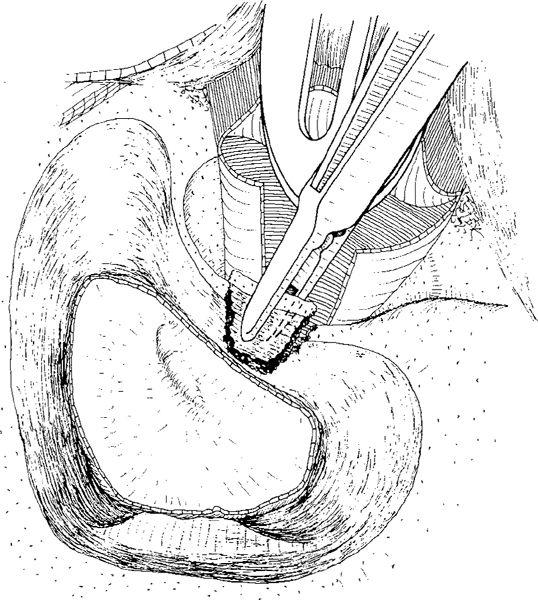
Fig. 571 The bony ear canal wall is removed using a strong rongeur, piece by piece, or using a cutting burr

Fig. 572 Remnants of bony ear canal wall are left along the zygomatic region and along the facial ridge. The anterior buttress is carefully removed with a curet, as is the posterior buttress, exposing the medial wall of the attic retraction, the head of the malleus, and the incus body. Extensive drilling of the borders of the ear canal wall now takes place superiorly and at the facial ridge
Reconstruction in Bondy’s Operation
The skin flaps are replaced, and the inferior ear canal skin flap covers the facial ridge and the inferior part of the cavity (Fig. 574). The anterior skin flap covers the mastoid tegmen and tegmen tympani, and epithelialization can take place. The lateral skin flap is sutured as a Körner’s flap to the posterior edge of the cavity. Reconstruction in Bondy’s operation is easy, especially if all the meatal skin is preserved and the cavity is not too large, as is the case with a sclerotic mastoid process or diminished pneumatization. After the medial part of the cavity has been packed, a meatoplasty is performed.
If the hearing is good and the matrix covers both the lateral aspects of the incus body and malleus head, then the functional results can be excellent.
Bondy’s operation is not without drawbacks. Incomplete mastoid cell removal often leads to chronic discharge from the mastoid cavity. Residual cholesteatoma matrix can continue eroding the bone and stimulate the formation of granulation tissue. In addition, incomplete mastoid tip cell removal, with a resulting lack of ventilation, can cause infection and granulation. Bondy’s operation is therefore no longer the preferred procedure in open cavity techniques in many centers.
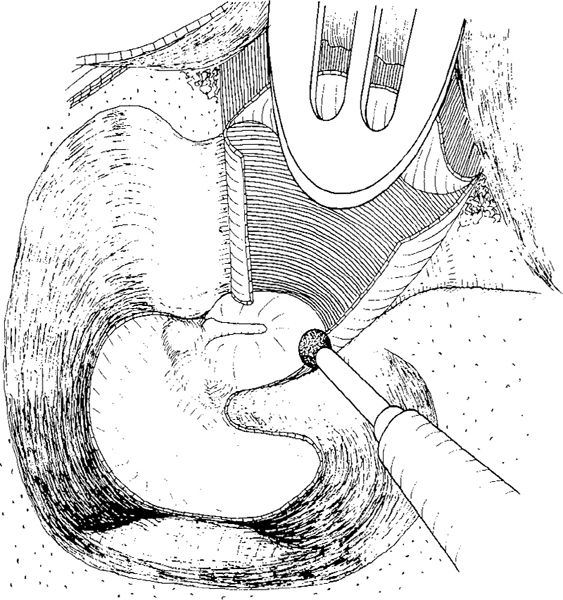
Fig. 573 Anteriorly, the ear canal wall has been smoothed without overhangs, with a good transition from the anterior ear canal wall to the mastoid tegmen. Posteriorly, the facial ridge has been lowered considerably and made smooth using a diamond burr, and the cavity is now ready to be reconstructed
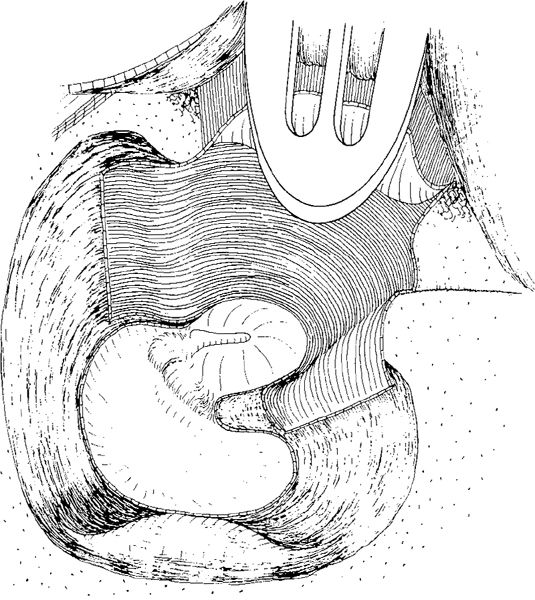
Fig. 574 Reconstruction of the open Bondy cavity. The superior meatal skin is placed over the mastoid tegmen. The medial walls of the attic and antrum wail, including the ossicles, are covered with a solid matrix. The facial ridge is covered with an inferior ear canal skin flap, extending into the inferior cavity. The posterior part of the cavity will be covered with a laterally-based ear canal skin flap (a Körner’s flap) fixed to the posterior edge of the cavity
In small attic cholesteatomas and attic cholesteatomas with extensive resorption of the lateral attic wall, the ear canal can be removed before the cholesteatoma sac is opened (Fig. 10).
Preservation of the Cholesteatoma Matrix
As mentioned previously, the definition of Bondy’s operation, in addition to preserving the cholesteatoma matrix, includes the fact that the tympanic cavity is not entered. Bondy’s operation is therefore limited to selected cases with less extensive cholesteatoma and without major resorption of the incus or the malleus head.
In cases of attic cholesteatoma with extension into the tympanic cavity, either laterally or medially, or simply by resorption of the incus body and malleus head, the cholesteatoma has to be removed from the tympanic cavity. In a conservative radical operation with removal of the bony bridge or an atticoantrotomy, the cholesteatoma can be marsupialized and the matrix left in place in the attic alone (Figs. 12, 13). Some of the matrix is elevated, and the tympanic cavity is closed with an underlay fascial graft (Fig. 14).
The Sanna Modification
To stabilize the marsupialization techniques on a long-term basis, in canal wall–down mastoidectomy or Bondy’s operation, Sanna et al. (1994) introduced an improvement of the marsupialization technique, elevating the cholesteatoma matrix from the incus and including the posterosuperior part of the drum (Fig. 575), exposing the incudostapedial joint. A small piece of cartilage is placed under the short process of the incus, preventing later retraction. Another thin cartilage plate is placed on the long process of the incus and under the malleus handle, preventing posterosuperior retraction (Fig. 576). Both pieces of cartilage are covered with a specially cut fascia graft, placed under the drum (Fig. 577) which is replaced in the proper position, so are the matrix and the skin flaps (Fig. 578). Sanna also elevated the matrix, inspecting the perilabyrinthine cells to avoid ingrowth of the matrix into the cells. The indications for marsupialization and Bondy’s operation are wider with this modification.
The result of Sanna’s modification of the canal wall–down mastoidectomy technique is the same as that of Bondy’s operation (Landolfi et al. 1993). The marsupialization technique can sometimes be used to great advantage. In the majority of cases, however, a conservative radical operation with removal of the bridge is performed, including total removal of the cholesteatoma, leaving no matrix.
Baron (1949, 1967), a great advocate of preservation of the matrix in cholesteatoma surgery, suggested a number of rules for the preservation or removal of the matrix (Table 7).
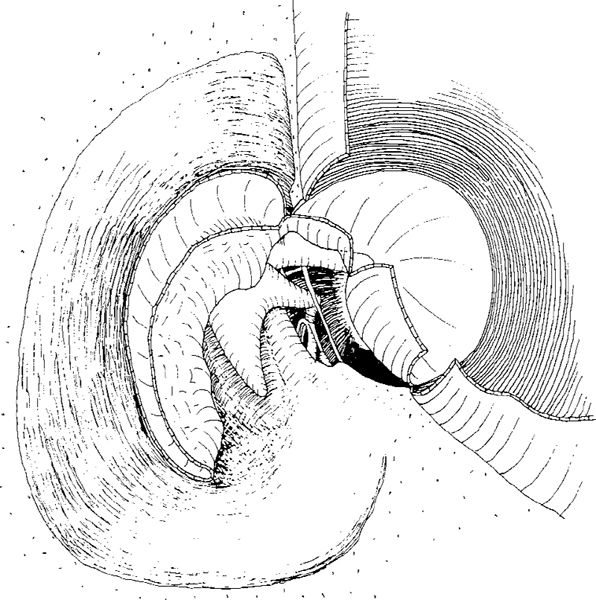
Fig. 575 The Sanna modification of the marsupialization technique and Bondy’s operation. The matrix covering the incus is removed and the posterosuperior part of the drum is elevated, exposing the intact incudostapedial joint
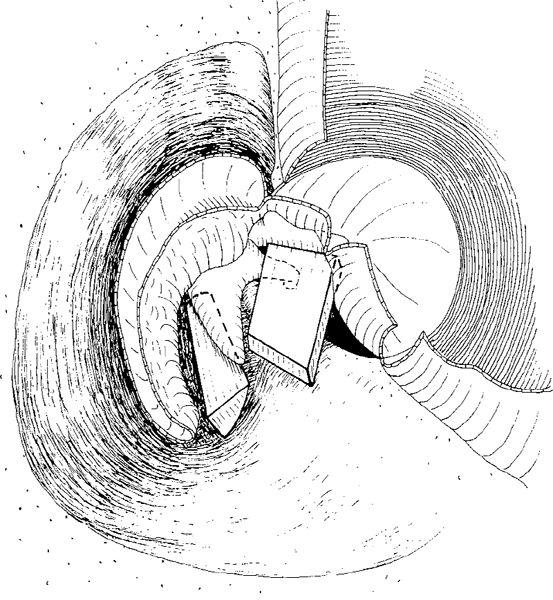
Fig. 576 A piece of cartilage is placed between the short process of the incus and the medial attic wall. Another rectangular piece is placed on the long process of the incus and under the malleus handle
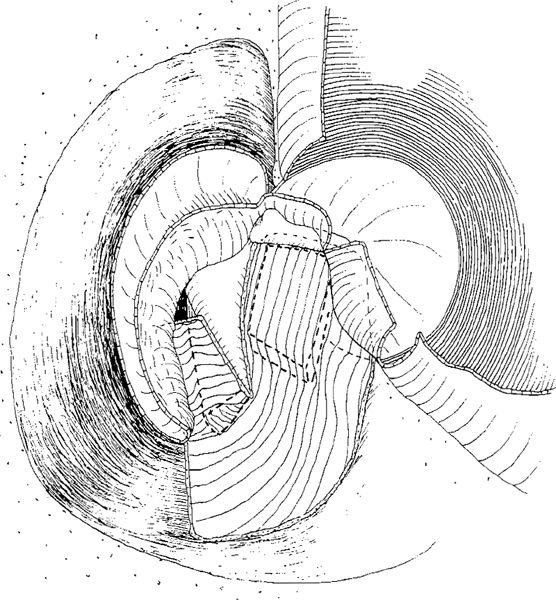
Fig. 577 A specially cut piece of fascia covers the cartilage, incus, and posterosuperior part of the drum as an underlay graft
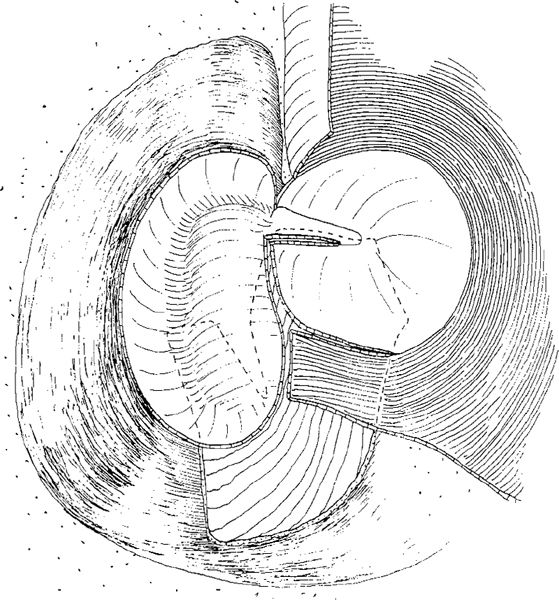
Fig. 578 The matrix and the drum are replaced in their original position
Table 7 Baron’s rules for preservation or removal of cholesteatoma matrix (Baron 1949, 1967)
Preserving the matrix 1 Cases with externalized squamous epithelium thatserves as a source of complete epithelialization forthe mastoid cavity, resulting in a dry ear. 2 For maintenance or improvement of hearing, especially in the ear with better hearing or in the onlyhearing ear. 3 In a sclerotic mastoid. 4 In a labyrinthine fistula. 5 In cases with exposed dura, sinus, or facial nerve. |
Removing the matrix 1 In a well-pneumatized mastoid. 2 With perilabyrinthine invaginations and fingerlike protrusions into the air cells. 3 In revision operations. 4 With retrofacial or petrous tip extensions. 5 With invagination into bone in any area. 6 For cases with hearing loss greater that 45 dB, thematrix should be removed and reconstruction of aconducting mechanism attempted. 7 Where there is suppuration between matrix and the bone. 8 With granulation tissue between islands of matrix. 9 In cases of labyrinthitis, petrositis, meningitis, sub-arachnoid abscess, epidural abscess, and lateralsinus thrombosis. |
Canal Wall–Down Mastoidectomy with Removal of the Bridge
A transcortical canal wall–down mastoidectomy is initially a cortical mastoidectomy, described in Chapter 4. Only the special techniques involving removal of the bridge, polishing of the anterior and superior walls of the cavity including its transition into the anterior ear canal wall, as well as removal of the facial ridge and the posterior buttress, will be described here.
After removal of the lateral mastoid air cells and Körner’s septum, the cavity is polished, and the large cells are removed, ensuring that no cholesteatoma and no granulation cholesteatoma with infection remains. The ear canal skin is elevated from the bony wall, preserving both a large superior and inferior skin flap.
Removal of the Bony Ear Canal Wall
The bony ear canal can be removed at any stage of a cortical mastoidectomy, but usually the antrum is entered and Körner’s septum is removed before the ear canal is taken down.
The removal of the ear canal can be performed using a rongeur. The use of a rongeur has the advantage that pieces of the ear canal can be used as obliterating material, or for reconstruction of the bony ear canal wall, or as an ossiculoplasty graft. Before removal of the ear canal wall, it is wise to drill it thin and clean the cavity lateral to Körner’s septum, polish the walls and sinodural angle, and exenterate the cells in the mastoid tip if there are any (Fig. 579). By following the air cells down to the mastoid tip before removal of the bony ear canal wall, the surgeon is able to judge how much of the canal has to be removed in relation to the facial ridge in order to achieve a safe cavity. In cases with a small air cell system, the lateral part of the ear canal is removed with a rongeur (Fig. 580) or drilled away using a cutting burr (Fig. 581) as far as the bridge, lateral to the ossicles. Using a rongeur or a diamond burr, the bridge is then drilled away (Fig. 582), and the drilling continues anteriorly in order to remove the remaining part of the bridge and smooth the anterosuperior part of the cavity.
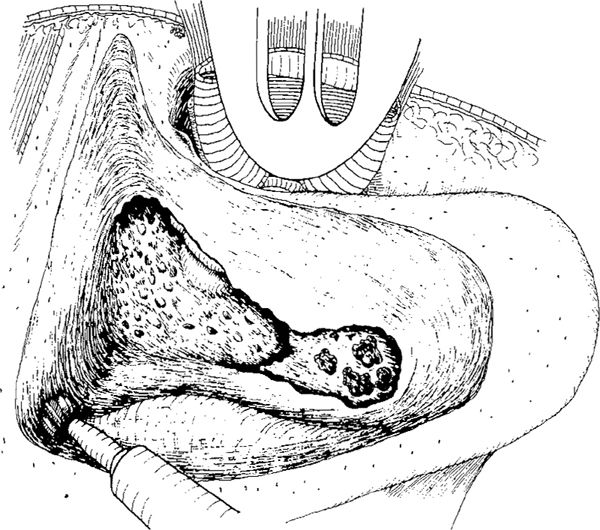
Fig. 579 Cortical mastoidectomy in a case with extension of the cells into the mastoid tip. The sinodural angle has been cleaned. The mastoid tegmen and the sigmoid sinus plate, as well as the posterior fossa dural plate, have been smoothed. The anterior attic will be opened after removal of the bony ear canal wall
Stay updated, free articles. Join our Telegram channel

Full access? Get Clinical Tree


